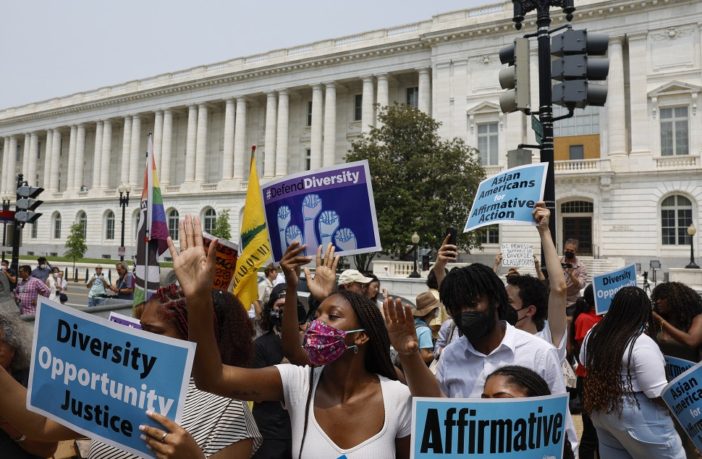You are here: Home / BM / Black Community: Meritocracy, American style.
Like
Like
Love
Haha
Wow
Sad
Angry
1
(ThyBlackMan.com) Let’s face it – the Ivy League discriminates against Asian American students. This is despite the fact that Asians are overrepresented in those eight schools and at other elite institutions (i.e., relative to their proportion of the general population). Indeed, Asians account for nearly 1/3 of the student population at Columbia University. Still, Asians would be admitted to elite schools in even greater numbers if “merit” (as defined by grades and test scores) were the only admission criterion. That is a fact. It is also a fact that the primary beneficiaries of lower admission rates for Asians are white students – not Blacks or Latinos.
A recent study from the National Bureau of Economic Research found that 43 percent of white students who were admitted to Harvard came from four categories: “legacies” (i.e., children/grandchildren of alumni); children of faculty or staff; athletes; or on the dean’s “interest list” (i.e., children of people who donated). The study also revealed that roughly 75 percent of the white students who were admitted from those four categories “would have been rejected” if they had been judged on the same criteria as other white students.
The study tells a very different story regarding Black, Latino, and Asian-American students. Specifically, fewer than 16 percent of the students in these racial/ethnic groups came from those four privileged categories. (By contrast, the study found that nearly 70 percent of white students who were admitted were legacies – and were eight times more likely to be admitted.) Still, the majority of the Supreme Court has formally patted itself on its proverbial back for allegedly making America Great Aga… I mean, less racially discriminatory. Yet, as Tayo Bero wrote, “Affirmative action is over in the United States, but only for Black people.”
For the record, America has never been a meritocracy. Indeed, America was never intended to be a meritocracy. At our nation’s founding, only white men could vote. But not all white men; only white men who were of “property and standing” could vote. Poor white men were excluded – which is one of the reasons that wealthy whites embedded the relatively new concept of “race” into poor white men’s psyche. They may have barely owned the clothes they were wearing, but at least they weren’t Black. (This racial lens would expand and replicate as successive waves of European immigrants flooded our nation in the 19th and early 20th centuries.)
In any case, five white justices (and a Black one) – all of whom graduated from elite institutions – decided that there are too many Blacks and Latinos at elite institutions. And let’s be crystal clear on that point. This isn’t about community colleges or good old “state u”; this is about the Ivy League and other “highly selective” schools. The justices claim that racial discrimination isn’t really a “thing” at such schools anymore. Yet, a study by the Associated Press found that there were more legacy admits at Cornell, Dartmouth, Notre Dame, and USC than there were Black students at those schools. For the time being, SCOTUS has ensured that affirmative action – for legacies and others who are privileged – will remain entrenched.
Of course, the justices don’t actually believe their own propaganda. How do I know? They are willing to countenance affirmative action in the military. Encouraging more Blacks to be available to die for America is acceptable to the “Colorblind Six”, but enrolling in Ivy League schools? Not so much. But wait, there’s more! During this term, these unelected, activist justices usurped the authority of the Executive Branch vis-à-vis student loans before they decided to dictate to admissions officers how to do their jobs. Their arrogance is exceeded only by their hypocrisy.
Speaking of hypocrisy, it is spectacularly evident in one particular justice. Clarence Thomas directly benefitted from affirmative action by being attending Yale Law School after it consciously decided to admit more Black students. (Even Thomas admits as much, if derisively.) Moreover, then President George H.W. Bush nominated Thomas to the Supreme Court primarily because he is Black. As Justice Thomas wrestles with his demons of self-abnegation, one would have hoped that he would not have “pulled up the ladder” for those who are climbing after him. Hope be damned.
Another issue is the fact that this ruling isn’t about more Asian Americans being admitted to elite schools. This is the false claim that is made by Edward Blum, the well-funded, radical crusader who is behind the push to end race-based affirmative action. I say, let’s call Mr. Blum’s bluff. Let’s push for Harvard, et al to have their incoming classes be 75% Asian American. Force the elite schools to tighten admission requirements even more so as to substantially hamper the ability of white applicants from “the four categories” to game the system. If that reality ever came to be, I’m certain that Blum would be first in line to fight for racial diversity (i.e., the admission of more white students).
Blum and his ilk are employing a cynical – and highly effective – “divide and conquer” strategy that pits people of color (especially Blacks and Asians) against each other. By using Asian Americans as pawns, Blum can claim that his true goal is “merit-based diversity”. He found allies in this version of SCOTUS. Chief Justice John Roberts has long said that “The way to stop discriminating is to stop discriminating.” (He means that affirmative action “discriminates” against white people.)
Even if we take Roberts and the court’s majority at their word (and I don’t), one wonders why this particular issue is the “racial equality” problem on which they chose to hang their collective hat. I understand that SCOTUS only acts on cases that appear before it, but the institution chooses which ones to deliberate. Rather than address actual racial animus in our nation, they chose to offer a solution to a pretend problem.
If SCOTUS were actually concerned about creating equal opportunity, it would rule in favor of those who (for example) are fighting to eradicate race-based differences in income. In short, white people earn more money than Black people do at every postsecondary educational level, from bachelors degrees to doctorates. In fact, in many instances white people who have high school diplomas earn more money than do Black people who have earned a college degree!
Further, as has long been noted, there is a difference between “invidious” discrimination (e.g., Jim Crow) as compared to “benign” discrimination (e.g., affirmative action). Roberts and company are engaging in a morally perverse game of false equivalency: “America has always discriminated against African Americans, which was really, really bad – you know, slavery and such. Now, America is doing the same thing to privileged whites who don’t get into their top choice of college. That’s really, really bad!”
This argument is as ludicrous as it is disingenuous. Consider the aftermath of the Civil War. The 13th, 14th, and 15th amendments to the Constitution were passed to redress the evils of slavery and the most pernicious forms of racial discrimination. It is legitimate to wonder whether this version of the Supreme Court would have sided with former slaveowners who felt slighted after losing “the war of Northern aggression”. I digress…
We knew that this ruling was coming, but it still felt like a sucker punch. This decision is consonant with the fact that most white Americans do not want a true meritocracy because that would mean the death of white privilege. I am not saying that most white Americans are racist; I am saying that most white Americans favor “meritocracy” only to the extent that it doesn’t interrupt white privilege – especially among the wealthy. (The admissions debacle at one of my alma maters, Stanford University, comes to mind.)
As I have long argued, the logical “solution” to the “problem” of affirmative action is simply to go back to a time in which elite institutions didn’t admit Blacks and non-white Hispanics. That is the only way to ensure that white people are not “discriminated” against. Racial equality (not to mention racial equity) will always be viewed as a zero-sum game by Blum and his comrades; there will be “winners” and there will be “losers”. The only truly fair and equitable approach – the only way to achieve a true meritocracy in college admissions – would be to remove all preferences: legacies, athletes, racial minorities, the wealthy (and the otherwise well-connected). Of course, that will never happen.
Detractors will counter that “unqualified” people shouldn’t be advanced in top schools or for top jobs, as if anyone is actually making the argument that they should. That argument has always been a smokescreen.
The fact is that these schools already choose from a pool of students who are qualified to be admitted irrespective of their race.
African Americans were denied admissions to top schools for a few hundred years in spite of our being qualified to attend them. Affirmative action was intended in large measure to counteract racial discrimination that was based on the false premise of our intellectual inferiority. That false premise will not somehow disappear just because affirmative action went away. All the Court has achieved is entrenching racial privilege for less qualified whites.
What did the plaintiffs “win”? In other words, what’s going to be the practical outcome of this decision? Even fewer Blacks and Latinos will attend “elite” institutions – replaced by a few more whites and (presumably) a few more Asians. I suppose that congratulations are in order. (What is the sound of one hand clapping?)
Additionally, this ruling will have ramifications beyond college admissions. For example, on the day that the SCOTUS ruling was handed down, the Republican Attorney General of Missouri ordered all schools in his state to end minority scholarships.
Why should we care that fewer Black and Hispanic students will be admitted to elite schools? The answer is simple. The economic ramifications of lower numbers are real. This is not conjecture on my part. An incoming professor at Princeton University studied what happened to Black and Hispanic students after California banned affirmative action in college admissions 25 years ago. The punchline? Black and Hispanic students do worse economically and educationally, while white and Asian students are no better off.
As we commemorated the Fourth of July earlier this week, I saw numerous social media posts lamenting the notion that African Americans seem to be less patriotic – despite the fact that we are overrepresented in the military (especially Black women). Could it be that part of the reluctance among some Blacks to joyfully participate in jingoism is due to the fact that America keeps reminding us that we don’t really belong here, including in elite schools – except to the extent that we dunk basketballs or score touchdowns?
These days it is common to hear the phrase, “Education is the civil rights issue of our generation”. If that is true, the Supreme Court just told us that civil rights are not important to them. Of course, we didn’t need any more evidence to know that.
Written by Larry Smith



